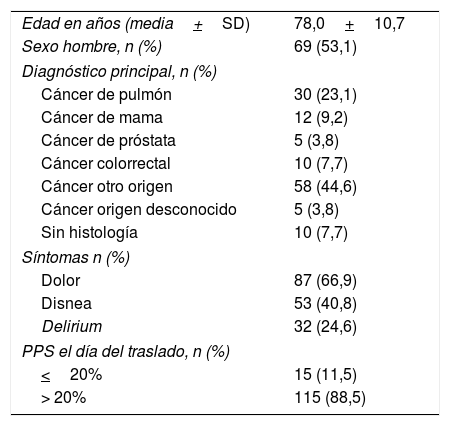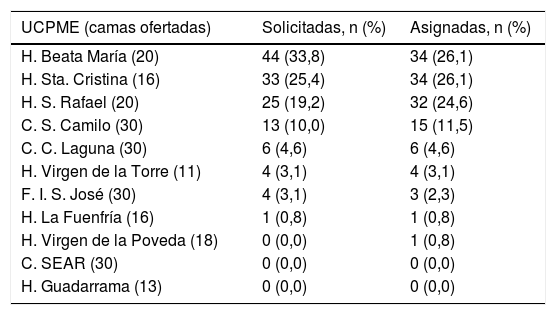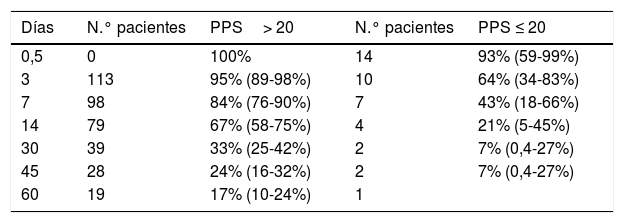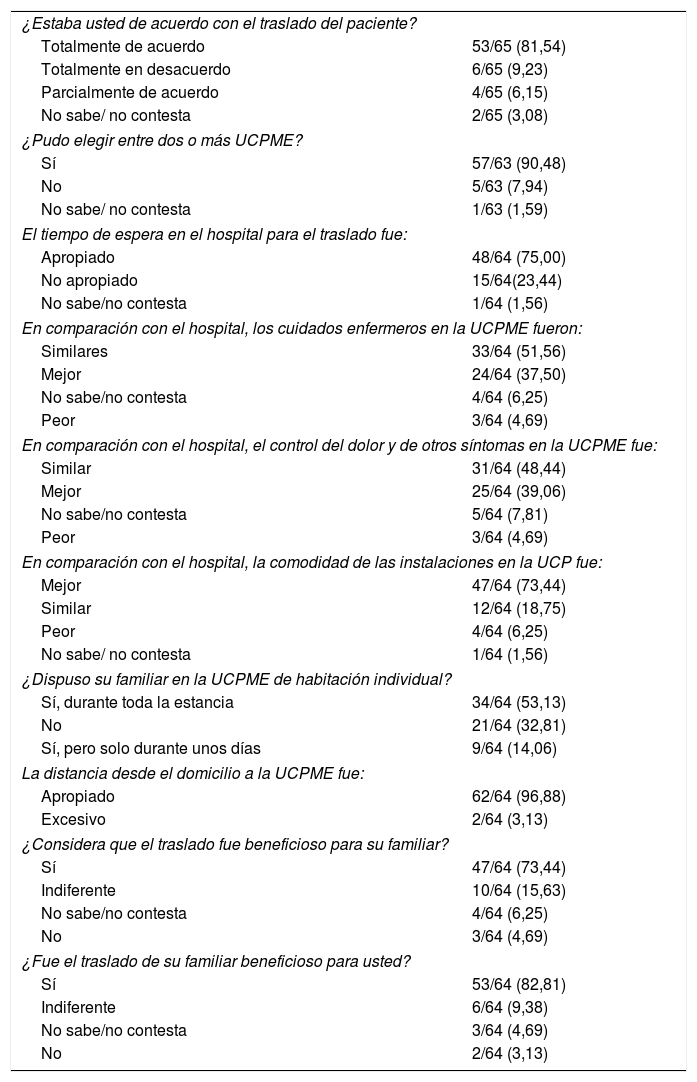La gestión clínica aplicada a pacientes terminales debería considerar diferentes aspectos, particularmente la valoración funcional que correlaciona bien con pronóstico a corto plazo. La estimación pronóstica podría mejorar si se incluyera la presencia de síntomas fuertemente asociados a peor evolución.
El objetivo principal del estudio fue evaluar si el pronóstico según Palliative Performance Scale (PPS) mejoraba con la presencia/ausencia de los síntomas dolor-disnea-delirium. Secundariamente estimar la satisfacción de los cuidadores con el traslado a Unidades de Cuidados Paliativos de Media Estancia (UCPME), preparadas para estancias medias deseables en torno al mes.
Pacientes y métodoEstudio prospectivo, observacional, multicéntrico (autonómico). Se analizó supervivencia en UCPME según PPS dicotomizado en>o≤20%. Se estimaron sus funciones de supervivencia mediante método Kaplan-Meier y se compararon según riesgo proporcional de Cox (HR). La satisfacción de los cuidadores se estudió mediante cuestionario anónimo autocumplimentado tipo Likert.
ResultadosIncluimos 130 pacientes. Los subgrupos PPS ≤ 20% y PPS>20% tuvieron una mediana de supervivencia de 6[3-13] y 21[11-42] días respectivamente, con HR no ajustado 3,1 veces mayor de fallecer en PPS≤20%. El HR no se modificó ajustando para los síntomas. El 83% de cuidadores encontró el traslado beneficioso y el 40% apreciaron mejores cuidados sanitarios.
ConclusionesEn pacientes trasladados desde hospitales generales a UCPME puntuaciones PPS<20% se asocian a supervivencia menor de una semana con HR 3 veces superior de fallecer que pacientes PPS>20%, sin que el análisis ajustado por presencia de dolor-disnea-delirium aporte mayor precisión pronóstica. Los cuidadores encontraron beneficio fundamentalmente en comodidad de instalaciones y distancia.
Clinical management for terminal patients should consider various aspects, particularly the patient's functional assessment, which correlates well with the short-term prognosis. The prognosis could improve if the presence of symptoms strongly associated with a poorer progression were included.
The study's main objective was to assess whether the prognosis according to the Palliative Performance Scale (PPS) improved with the presence/absence of pain-dyspnoea-delirium symptoms. The secondary objective was to determine caregiver satisfaction with the transfer to medium-stay palliative care units (MSPCUs), which are prepared for medium stays of approximately one month.
Patients and methodWe conducted a prospective, observational, multicentre (regional) study that analysed survival in MSPCUs according to the PPS dichotomized to>20% and≤20%. We estimated the mean survival functions using the Kaplan-Meier method and compared them according to the Cox proportional hazards ratios (HR). Caregiver satisfaction was studied using an anonymous self-administered Likert questionnaire.
ResultsThe study included 130 patients. The PPS≤20% and PPS>20% subgroups had a median survival of 6 (3-13) days and 21 (11-42) days, respectively, with an unadjusted mortality HR 3.1-fold greater in the PPS≤20% subgroup. The HR did not change when adjusted for the symptoms. Eighty-three percent of the caregivers found the transfer beneficial, and 40% observed better patient care.
ConclusionsFor patients transferred from general hospitals to MSPCUs, PPS scores≤20% were associated with survival shorter than one week, with a 3-fold higher mortality HR than patients with PPS scores>20%, without the analysis adjusted for the presence of pain-dyspnoea-delirium providing greater prognostic accuracy. The caregivers found benefits mainly in the convenience of the facilities and distance.
Artículo
Diríjase desde aquí a la web de la >>>FESEMI<<< e inicie sesión mediante el formulario que se encuentra en la barra superior, pulsando sobre el candado.

Una vez autentificado, en la misma web de FESEMI, en el menú superior, elija la opción deseada.

>>>FESEMI<<<











